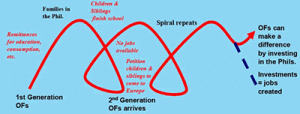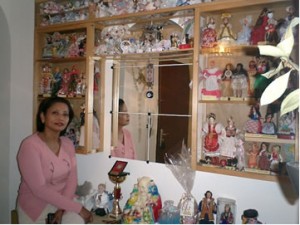by JEREMAIAH M. OPINIANO
www.ofwjournalism.net
STRASSEN, Luxembourg–BLADES of scissors meet, snips the head, and severs it from other people in the photograph. It’s the head of the 200th undocumented Filipino who Remie Becker has helped settle down here.
“There,” Becker, pushing fifty, whispers as she glues the raggedly-cut head shot on a collage of similarly unevenly-scissored photographs –some cut from the neck, some from the waist– of Filipinos who have sought her help since they began arriving here from the eighties.
She leans back on a hand-carved oak chair and stares at the framed collage. Crow marks appear on her face for a wistful smile.
These are rare times when Becker, who arrived here in 1978 as spouse of aviation specialist Hans, could be by herself and rest: the 201st Filipino migrant worker has yet to knock on her door.
She is used to the intrusions as she has comfortably slid into the role as “godmother,” but not of the Mario Puzo gun-blasting type.
Still, like Don Corleone, Becker is there when asked to attend weddings, baptisms, birthdays, and coming-out parties. The cake figurines arranged on a cabinet attests to her presence in these traditional gatherings that congeals the blood ties in the Filipino race represented in Europe’s investment capital.
Some consider Becker their beacon of Filipino generosity.
“She gives moral support; doesn’t scrimp on good advice when asked,” Perla Aachten said.
Becker also gives money when she has them or when the need is grave, according to Aachten.
“Her house is always open for those needing a night or several nights’ stay,” she added; with Becker not expecting any payment at all.
What she does hope for, she tells the OFW Journalism Consortium, is that other Filipinos shower each other with the same kindness and assistance she extends, even while still in the motherland.
Becker’s hope, however, remains dashed as Filipinos themselves, like Aachten, appear to be giving up.
Solo flight
THOUGH SLIGHTLY mute, the news aired over a television at the Filipino Community Centre in Toronto, Canada, made a 60-year-old Filipino wince.
“There is no more hope in the Philippines,” the white-haired migrant said, “and I will not go back there.”
Anthropologist Michael Tan wasn’t surprised.
“All this migration has further eroded our weak sense of nationhood –and without that, the Philippines and Filipinos everywhere will not develop,” says Tan, who teaches at the state-run University of the Philippines.
“Some people abroad will then think of the Philippines as the world’s backwaters,” he added.
Tan explained that Filipinos who go abroad “become even more individualistic and more disdainful of the Philippines.”
When pressed to comment about Becker, he said that while there are “many good and nationalistic Filipinos abroad, they remain a minority.”
Indeed, Aachten’s involvement in a group here that pools money to invest in the Philippines appear small when compared to the money funneling the departure of nearly 3,000 Filipinos a day.
The 59-year-old Aachten deposited some P20,000 (317.61 Euros) in a microfinance rural bank in Bukidnon province that used the money as loan to four residents starting up or expanding businesses.
Her money gains an annual 10-percent interest compounded over five years, or an additional P10,000 (158.805 Euros) by 2011.
Still, Aachten admits it wasn’t –and still isn’t– easy to encourage her compatriots here to join the group.
“They told us we’ll just rake in money from them, and they’d rather use the membership fee as wager for tong-its (Filipino version of poker),” she says.
She says she always bristle when the latter reason is hurled at her.
“I get irritated,” Aachten said and apologizes later.
Calming herself, however, she says not all Filipinos are difficult to convince.
“I don’t generalize that Filipinos are all like that,” Aachten said adding that many of those whom Becker helped are reciprocating the kindness extended to them by supporting the group even by not being members.
Circle spiral
ALTHOUGH MANY migrants fare well abroad, they and the country are caught in a spiral that Luxembourg-based migrant advocate Dennis Yaun thinks has become repetitive (see figure 1).
 |
| Figure 1: “Spiral of Filipino overseas migration” (by Dennis Yaun, Luxembourg) Image courtesy of the ECONOMIC RESOURCE CENTER FOR OVERSEAS FILIPINOS (ERCOF) |
“For as long as development problems continue to propel Filipinos in the homeland to migrate, and force compatriots abroad to remain settled elsewhere, the spiral of migration continues,” Yaun asserts.
Economist Fernando Aldaba agrees.
Conditions back home have led Filipinos to make “individually rational” decisions to migrate, says the Ateneo de Manila University professor.
“But from (Philippine) society’s point of view, is this also rational?” Aldaba says.
The answer to that is the lack of choices for the Filipino, according to Corazon Raymundo of the Demographic Research and Development Foundation in Manila.
“If we are in a no-choice situation, we are not getting anywhere but down,” Raymundo says.
Does migration undermine the national, collective consciousness and encourages selfishness then? Melen MacBride of Stanford University isn’t surprised if it does: “Filipinos have been attuned to beng islanders going to safe places to protect themselves.”
Once abroad or even upon their return to the Philippines, however, Filipinos always try to build a community regardless of their circumstances.
Some do this by living together, like this apartment unit beside a restaurant here.
At the third floor, a unit with six rooms has become the home of a dozen Filipinos. Almost every Friday evening, the voices of these six couples fill the apartment as they sing along to a dot bouncing on letters beamed from a music video.
Other communities naturally grow, like the San Francisco General Hospital across the continent where at exactly 4:30 p.m. the canteen is filled with banter in Tagalog.
Some communities are in actual neighborhoods abroad, says MC Canlas of the nonprofit Filipino-American Development Foundation. One is in nearby Daly City where the Filipinos are a third of the population, and the other is in San Francisco’s South of Market where there’s a Filipino plaza or poblacion (see figures 2 and 3 on the next page).
Heaven’s door
BECKER SHUFFED briskly from her seat as the doorbell rang. The worried look on her face, however, was lifted when she saw the visitors, mostly Filipinos, were part of a group drumming investment for the Philippines.
We know we’re a handful; we’re who you observe as ‘minority’ but we have ways to imbibe hope on the Philippines unto fellow Filipinos, Becker later says.
That group she fed, sang and shared jokes with until three in the morning when all of Luxembourg are fast asleep.
Aachten says later these are the times they cherish, when everything unnerving about the Filipino dissipates like a bad dream and makes the Philippines the paradise millions still long to return to.
She and Becker knows the path to attain that dream is not paved in gold.
Indeed, to reverse the phenomenon of overseas labor export is a daunting task.
Former International Labour Office migration branch chief Manolo Abella says the Philippines need to have a 10-percent domestic growth rate for 23 straight years to attract compatriots to go back home.
But for Aachten and Becker, the evenings they spent helping undocumented Filipinos get on his or her feet here are little things they could do.
And Becker could only wish that that photograph she glued on the collage is the last of the line and the knock on the door would again be of Filipinos seeking investments to their homeland.
OFW Journalism Consortium and the Yuchengco Media Fellows Program
University of San Francisco Center for the Pacific Rim
